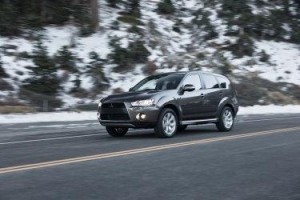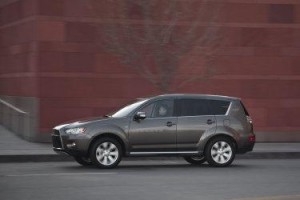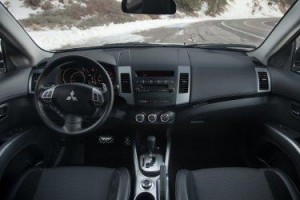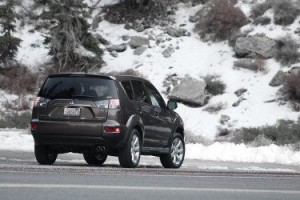Mistubishi’s 2011Outlander GT-S makes average music
By Eric Tegler
A “mashup” for those of you not on top of the hip hop or DIY-punk musical scene (oh, the un-hipness!) is simply a blend of two or more pre-recorded songs, usually by overlaying the vocal track of one seamlessly over the instrumental track of another. Think of the Outlander GT-S as a crossover utility vehicle overlayed with Mitsubishi’s rally-inspired Lancer Evolution.
The mashup starts with the look of the Outlander. Its large, blacked-out trapezoidal grille makes a “Gonna gobble you up!” statement. But its roof/window line is more conservative. In fact, it looks noticeably like Toyota’s RAV4 from the side. The Outlander GT-S’ wheel arches, dual tip exhaust, and rear LED taillights visually add a bit of the racer quality of the Evolution to what is otherwise a conventional crossover.
The Outlander’s size, right in the heart of the small SUV range is pretty conventional. Passenger volume (100.4 cu.ft.), and cargo volume (72.6 cu.ft. behind the front seats/over 36 cu.ft. behind the second row) are solidly mid-pack. Kudos to Mitsubishi for the Outlander’s clever “flap-fold” tailgate – with the main tailgate door swung up and open, the flap-fold swings down much like a pickup tailgate, lowering lift-over height and providing a place to perch items or people. The Outlander’s folding/tumbling rear seats free up cargo space and the second row’s sliding/reclining adjustability is appreciated.
Though interior room is good, the dash and control layout is uninspired with an expanse of black plastic reaching forward to the windshield. The optional touch screen is smallish and the control buttons surrounding it, smaller still. The seats are supportive and the leather appears relatively well done though when unoccupied the front passenger seat rattled.
The Outlander’s available powertrain packages are certainly conventional. In addition to the base four cylinder, a 3.0 liter V6 is available and standard on the GT-S. The engine makes 230 hp/215 lb-ft. and combines with Mitsubishi’s six-speed “sportronic” automatic transmission complete with paddle shifters. The paddles are large and well-placed on the column, facilitating quasi-performance driving though the gearbox doesn’t offer the speedy shifts of the Evo’s twin-clutch transmission.
The company says the 3.0 liter provides the “power of a sportscar” but it’s actually outgunned by the Ford Escape’s V6 (240 hp) and the relatively staid RAV4’s (269 hp) sixer. Add the GT-S’s 3,780 pound curb weight and the Outlander hits 60 mph in a respectable but not exceptional 8.0 seconds.
All-wheel drive – “Super all-wheel control” or S-AWC in Mitsubishi lingo – is part of the GT-S package. The system includes an electronically-controlled front differential which can allocate power to the left or right side wheels according to which has the most traction. A center console-mounted rotary switch allows the driver to select snow or lock (locking the differentials) settings when the system is not in the normal or rally-esque “tarmac” mode as Mitsubishi calls it.
The sportronic trans employs the company’s Idle Neutral Logic which automatically shifts it into neutral when the vehicle stops with the brakes applied, lessening the amount of power needed to turn the transmission, thus increasing fuel efficiency. Its contribution is marginal at best and during our largely city-type driving cycle the Outlander GT-S averaged a disappointing 16.7 mpg.
A more successful mashup would have injected more verve into the Outlander’s driving character but behind the wheel you never feel particularly enthusiastic. The crossover-ness of the GT-S is obvious despite better turn-in and cornering prowess than some of its competitors. There’s some suspension harshness over bumps and levels of wind and tire noise that drown out the Rockford Fosgate premium sound system. More annoyingly, a ceaseless rattle emanated from somewhere in the dash and I detected what might be a belt or pulley sound from the engine compartment. On start-up the engine sounds positively metallic and though the exhaust note is okay, the V6 just sounds harsh from behind the wheel.
Some mashups work and some don’t. The Outlander GT-S provides a small dose of sportiness in what isn’t an intrinsically sporting (on or off-road) vehicle segment. As a straight-ahead crossover utility it is competent but not exceptional and with the near $33,000 sticker as tested here, there are a lot of appealing alternatives.
The Specs
Price as tested: $32,495
Engine: 230 hp, 3.0 liter MIVEC V6
Curb weight: 3780 pounds
Fuel Economy: 19 city/25 highway




Leave a Reply